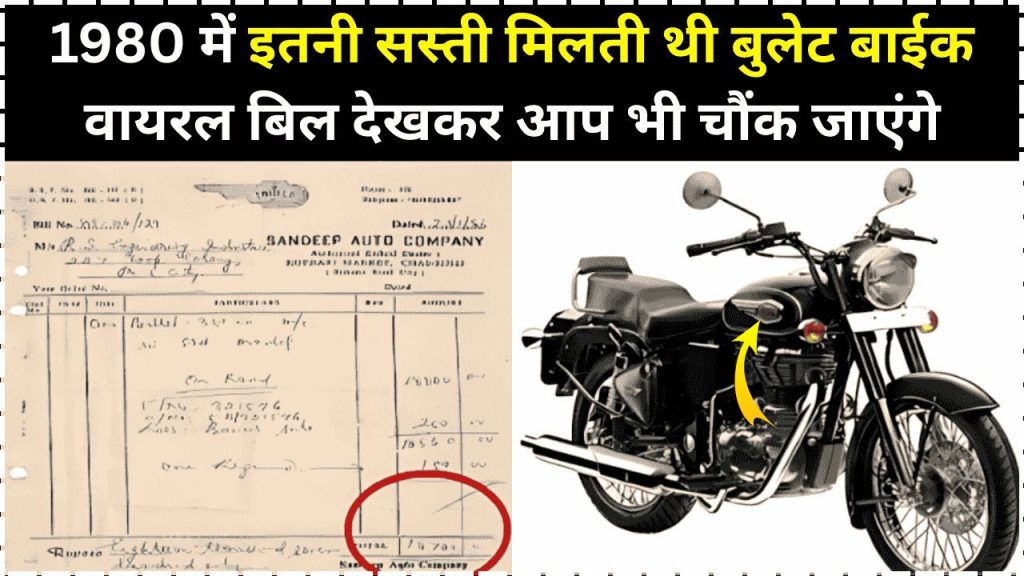
In today’s world, where motorcycles can cost as much as a small car, a photo from the past has taken social media by storm. It’s a simple image—an old bill from 1980 showing the price of a Royal Enfield motorcycle. But this image has opened a floodgate of memories and surprised bike lovers across India. Why? Because the price back then was unbelievably low compared to today.
Let’s take a walk down memory lane and explore the story behind that viral bill and how Royal Enfield has changed over the years.
The Viral Bill That Shocked Everyone
The bill showed that in 1980, a brand new Royal Enfield Bullet could be bought for around ₹6,000 to ₹8,000. That’s not a typo. Just a few thousand rupees for a motorcycle that is now considered a premium product.
To put this in perspective, the starting price of a Royal Enfield today is anywhere between ₹1.5 lakh to ₹3.5 lakh, depending on the model. Even if you account for inflation, the price back then was much more affordable for the average person.
Back in 1980, buying a Royal Enfield was still a big deal—it wasn’t cheap. But it was within reach for many families, especially those who needed a strong and reliable ride. Today, it’s more of a lifestyle choice than just a way to commute.
A Brand with a Long Journey
Royal Enfield started its journey in 1901 in Redditch, England. But its Indian chapter began in 1955 when Enfield India began assembling the bikes in Chennai. By the 1980s, Royal Enfield had made a strong name for itself in India.
Even though the parent company in the UK shut down in 1970, the Indian unit kept going strong. The Bullet model, in particular, became a symbol of power, trust, and rugged performance.
During the ’80s, these motorcycles were common among army personnel, police officers, and government officials. If someone rode a Bullet back then, it meant they were someone important—or at least wanted to look the part.
From Workhorse to Status Symbol
In the 1980s, the Royal Enfield was all about performance and toughness. It was a tool—meant to handle rough Indian roads, carry heavy loads, and last for decades. People bought it because it worked, not because it made a fashion statement.
Fast forward to today, and the story has changed. Royal Enfield is no longer just a motorcycle brand; it’s a lifestyle. Owning one is like joining a club. You’re not just buying a machine—you’re buying an experience.
Whether it’s long road trips, weekend rides, or group tours to the mountains, today’s Enfield riders often look for adventure and style more than basic transportation.
Big Tech Upgrades Over the Years
One reason why the prices have shot up is the amount of new technology packed into modern Royal Enfields. Let’s be honest—the bikes from the 1980s had their charm, but they weren’t very advanced.
Those old models were known for heavy clutches, oil leaks, and lots of vibrations. They didn’t have features like fuel injection, ABS (anti-lock braking system), or modern suspension systems. Riders had to be a bit of a mechanic themselves to keep the bike running smoothly.
Today’s models, on the other hand, come with smooth engines, better safety features, digital displays, and comply with modern emission rules. All this requires research, development, and better parts—which naturally adds to the cost.
Old is Gold: Vintage Value Rising
If you happen to own a 1980s Royal Enfield in good condition, don’t sell it just yet! Vintage bikes have become collector’s items, and many are now worth as much—or even more—than some new models.
These classic machines have a different charm. Their design, sound, and feel are unlike anything you can buy today. That’s why collectors and hardcore fans are willing to pay a premium for them.
So, if your grandfather’s old Bullet is still lying in the garage, it might be time to give it some love and bring it back to life.
The Power of Nostalgia
That viral invoice from 1980 doesn’t just show us how prices have changed—it tugs at our emotions. It makes us think about the “good old days,” when life seemed simpler, and dreams like owning a Royal Enfield were within reach.
This is what marketers call “nostalgia marketing”—tapping into people’s fond memories to strengthen a brand’s image. Royal Enfield does this brilliantly. Even their latest ads and bike designs carry a touch of the past while embracing the future.
They’ve managed to keep the soul of the bike intact—those classic round headlights, the signature thump of the engine, and the timeless design—even as they add modern upgrades.
A Glimpse Into the Future
Royal Enfield today is not just surviving—it’s thriving. New models like the Meteor 350, Himalayan 450, and the Super Meteor 650 are proof that the brand continues to evolve.
With global expansions, new technologies, and electric bikes possibly in the pipeline, the company is looking forward without forgetting its roots. And that’s what makes Royal Enfield special—it’s a bridge between generations.
Whether you’re a young rider just starting your journey or someone who rode a Bullet 40 years ago, the Royal Enfield story has something for everyone.
FAQs
Q: How much did a Royal Enfield cost in 1980?
A: Around ₹6,000 to ₹8,000 depending on the model.
Q: Why are Royal Enfields so expensive today?
A: New technology, better safety, comfort features, and premium branding have increased costs.
Q: Are old Royal Enfields still valuable?
A: Yes! Well-maintained vintage models can be worth more than some new bikes.
Q: What makes Royal Enfield special?
A: Its unique combination of classic design, iconic sound, and rich history.